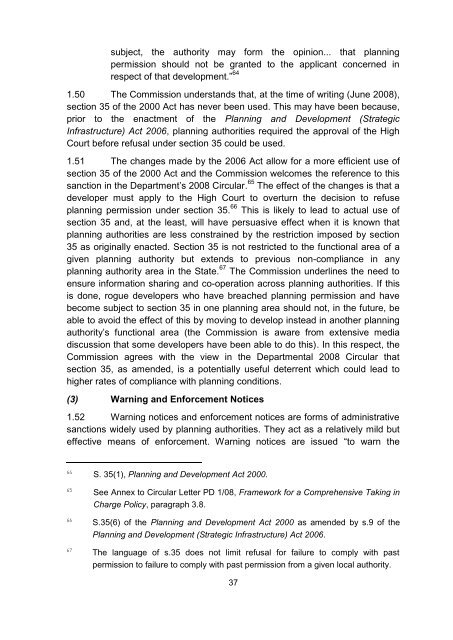Report on Multi-Unit Developments - Law Reform Commission
Report on Multi-Unit Developments - Law Reform Commission
Report on Multi-Unit Developments - Law Reform Commission
Create successful ePaper yourself
Turn your PDF publications into a flip-book with our unique Google optimized e-Paper software.
subject, the authority may form the opini<strong>on</strong>... that planning<br />
permissi<strong>on</strong> should not be granted to the applicant c<strong>on</strong>cerned in<br />
respect of that development.‖ 64<br />
1.50 The Commissi<strong>on</strong> understands that, at the time of writing (June 2008),<br />
secti<strong>on</strong> 35 of the 2000 Act has never been used. This may have been because,<br />
prior to the enactment of the Planning and Development (Strategic<br />
Infrastructure) Act 2006, planning authorities required the approval of the High<br />
Court before refusal under secti<strong>on</strong> 35 could be used.<br />
1.51 The changes made by the 2006 Act allow for a more efficient use of<br />
secti<strong>on</strong> 35 of the 2000 Act and the Commissi<strong>on</strong> welcomes the reference to this<br />
sancti<strong>on</strong> in the Department‘s 2008 Circular. 65 The effect of the changes is that a<br />
developer must apply to the High Court to overturn the decisi<strong>on</strong> to refuse<br />
planning permissi<strong>on</strong> under secti<strong>on</strong> 35. 66 This is likely to lead to actual use of<br />
secti<strong>on</strong> 35 and, at the least, will have persuasive effect when it is known that<br />
planning authorities are less c<strong>on</strong>strained by the restricti<strong>on</strong> imposed by secti<strong>on</strong><br />
35 as originally enacted. Secti<strong>on</strong> 35 is not restricted to the functi<strong>on</strong>al area of a<br />
given planning authority but extends to previous n<strong>on</strong>-compliance in any<br />
planning authority area in the State. 67 The Commissi<strong>on</strong> underlines the need to<br />
ensure informati<strong>on</strong> sharing and co-operati<strong>on</strong> across planning authorities. If this<br />
is d<strong>on</strong>e, rogue developers who have breached planning permissi<strong>on</strong> and have<br />
become subject to secti<strong>on</strong> 35 in <strong>on</strong>e planning area should not, in the future, be<br />
able to avoid the effect of this by moving to develop instead in another planning<br />
authority‘s functi<strong>on</strong>al area (the Commissi<strong>on</strong> is aware from extensive media<br />
discussi<strong>on</strong> that some developers have been able to do this). In this respect, the<br />
Commissi<strong>on</strong> agrees with the view in the Departmental 2008 Circular that<br />
secti<strong>on</strong> 35, as amended, is a potentially useful deterrent which could lead to<br />
higher rates of compliance with planning c<strong>on</strong>diti<strong>on</strong>s.<br />
(3) Warning and Enforcement Notices<br />
1.52 Warning notices and enforcement notices are forms of administrative<br />
sancti<strong>on</strong>s widely used by planning authorities. They act as a relatively mild but<br />
effective means of enforcement. Warning notices are issued ―to warn the<br />
64<br />
S. 35(1), Planning and Development Act 2000.<br />
65<br />
See Annex to Circular Letter PD 1/08, Framework for a Comprehensive Taking in<br />
Charge Policy, paragraph 3.8.<br />
66<br />
S.35(6) of the Planning and Development Act 2000 as amended by s.9 of the<br />
Planning and Development (Strategic Infrastructure) Act 2006.<br />
67<br />
The language of s.35 does not limit refusal for failure to comply with past<br />
permissi<strong>on</strong> to failure to comply with past permissi<strong>on</strong> from a given local authority.<br />
37

















